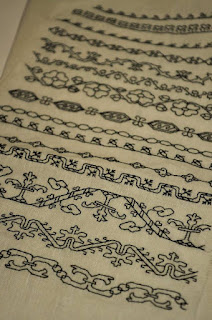So, you have learned the basics of how to do blackwork embroidery. Now you're interested in creating your own historical patterns, but maybe don’t know where to start?
First,
you need to find historical blackwork embroidery designs. Here are links to some examples:
- "Sir Thomas More and Family" (portrait is at the Nostell Priory and is part of the National Trust Collection)
- "Portrait of a Boy with a Marmoset" portrait is at the Kunstmuseum Basel (Basel Museum of Art in Switzerland)
- "Jane Seymour" portrait is at the Kunsthistorisches Museum in Vienna, Austria
Then,
decide which pieces of different designs that you like and which designs work
well with each other. Also, decide what the exact item is that you will be embroidering,
like a cuff versus a sleeve, to determine the size needed for your pattern. Keep
in mind how big or small you want your finished piece to be. For example, on
this sampler, I embroidered every third hole on the linen. The end result was a
small, delicate looking sampler.
However, if you embroidery every fifth hole
like on this collar of a linen partlet, your design will be much larger. Keep this in mind
when creating your design.
Now
it’s time to start piecing together your own design! On the first pattern, I combined the patterns found
on the collar of James Stewart, Earl of Murray (his portrait is at Darnaway
Castle) and the collar on the Portrait of a Boy with a marmoset found in the
Kunst Museum in Switzerland. I also added my own flare to the center of each
stem.
On
this second pattern, I combined the patterns found on the cuffs of Jane Seymour
(her portrait is at the Kunst historisches museum in Vienna, Austria), a flower
design from Bostocke Sampler (at the V&A Museum), and crosses from the
German blackwork patterns found in Nicolas Basee’s New Modelbuch and Hans Hofer’s
Formbuchlein.




No comments:
Post a Comment